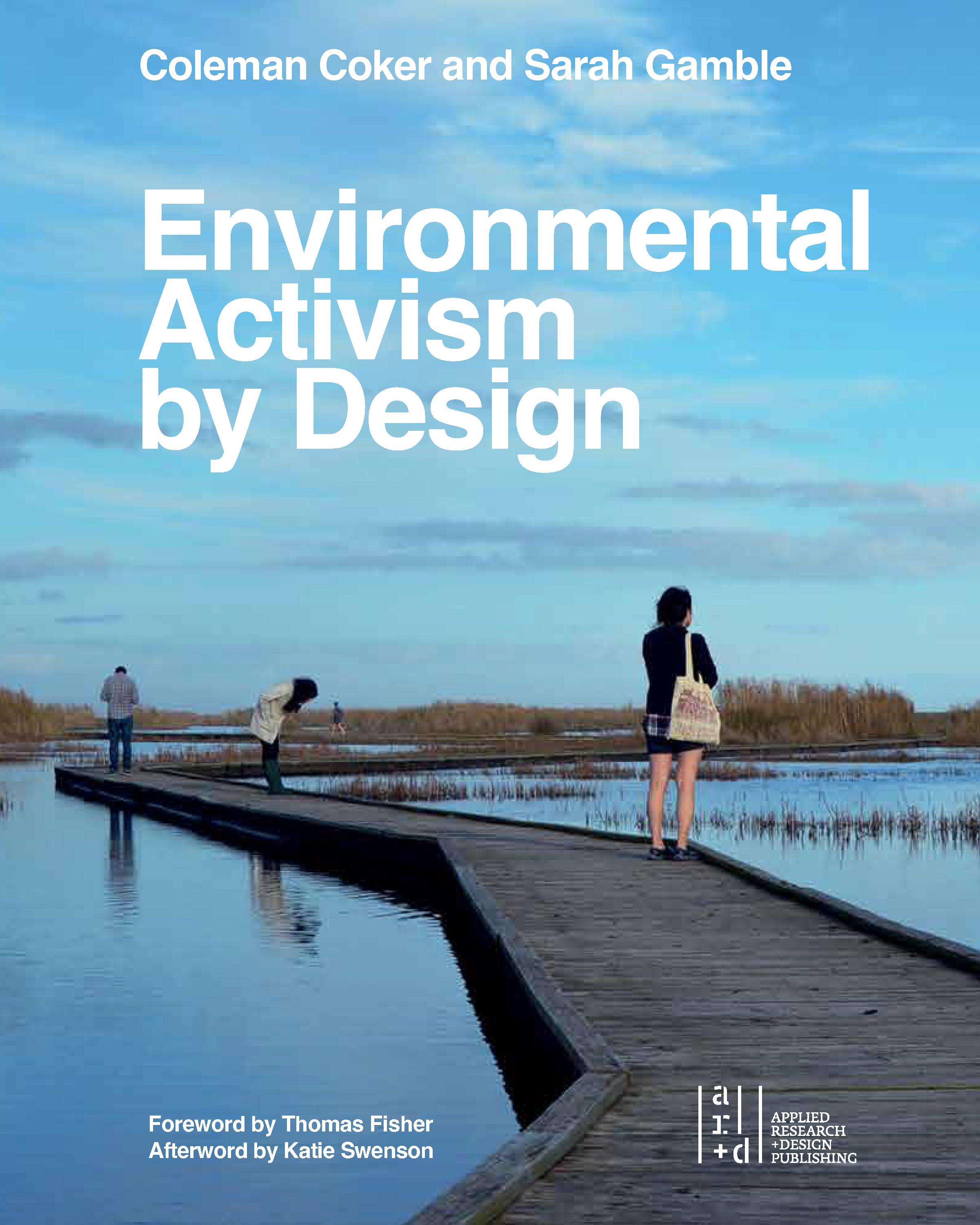
1 Wendell Berry, “How to Be a Poet,” Poetry Foundation, https://www.poetryfoundation.org/poetrymagazine /poems/41087/how-to-be-a-poet, Accessed 16 Feb 2022.
“Stay away from anything that obscures the place it is in. There are no unsacred places; there are only sacred places and desecrated places.”
— Wendell Berry, a portion of stanza two of “How to Be a Poet”1
TABLE OF CONTENTS FOREWORD An Architecture of Sentient Beings 7 INTRODUCTION 15 Projects Catalogue 25 CHAPTER 1 Red Tide, Red Necks and Littoral Drift 39 GATHER 51 FLOAT 59 CHAPTER 2 Gulf Coast DesignLab: A Model for Learning 69 RISE 91 STORE 99 CHAPTER 3 Act as If Your House Is on Fire 107 INHABIT 127 OBSERVE 135 CHAPTER 4 A Responsibility to Place 143 SHIFT 157 COOP 167 CONCLUSION Ripples of Hope 175 AFTERWORD Why Do We Do What We Do? 189 Acknowledgments 195 Author Bios 198

6
Environmentalists at Sea Rim State Park conducting their semiannual bird count from the deck of FLOAT.
© Coleman Coker
An Architecture of Sentient Beings
Thomas Fisher
Iwrite these words as the U.N’s 26th Conference of the Parties, the annual gathering of national leaders and environmental activists, just wrapped up its work in Glasgow, Scotland.1 While the conference produced agreements on how to address some key environmental challenges, such as curbing deforestation and clamping down on methane emissions, COP26 also showed the generational divide that exists across the globe between mainly older, government officials and the youth who will inherit the environmental damage those officials and their predecessors have done. One sign of that divide: over 100,000 youth protested in the streets of Glasgow as the politicians inside the conference center prevaricated. Meanwhile, the health of the planet continues to plummet.
The lack of urgency on the part of those in power in the face of extreme weather events of all sorts can cause one to give up hope in humanity’s long-term survivability. No other species depends as much as we do on so many other types of plants and animals in order for us to thrive, and as we harm them through our environmental negligence, we only harm ourselves—which may be the greatest paradox humanity faces. Never has there been a species more powerful than us, in terms of the knowledge we possess and the technology we deploy, and yet never has there been a species more reliant than us on the diversity of ecosystems that we continue to damage and more vulnerable to the climate change that we continue to cause. We are in the midst of what ecologists have dubbed the planet’s sixth great extinction, and the first one caused by an earth-bound creature: us.2 At the same time, we seemly ignore the possibility that one of species that we might cause to go extinct, through our own ignorance and carelessness, might be us.
In a situation like this, considering our responsibility to others—ethics— becomes not just an academic exercise but also a matter of life and death, to us
7
FOREWORD
as individuals and to humanity itself.3 Ethics asks us to think about the common good as opposed to our personal self-interest, although that typically occurs within a context in which we assume the future of the species is secure. But we can no longer assume that, given the speed with which we are extinguishing the very species we depend on. Consider the loss of bees, which pollinate one third of humanity’s food supply: without them, there will be fewer of us, and fewer of the other animals that also depend on the plants that bees pollinate, which means even less food for at least the meat eaters among us. 4
This requires a new way of thinking about ethics and about how we steward both the natural and built environments we create. The ethicist Peter Singer offers some useful guidance here.5 He argues that we need to judge the utility of our decisions based on their effect not just on other humans, but also on other animals, “sentient beings” as Singer calls them, who feel pleasure and pain as much as we do. And while plant life does not have the consciousness of animals, our well-being as sentient creatures depends upon the plant communities that they—and we—need in order to live. Singer has placed the classic utilitarian goal of creating the greatest good for the greatest number in a broader context and in a way that is well-suited to the environmental challenges we face, forcing us to ask who we must include in the greatest number when trying to do the greatest good. If we only include people in that calculation, we fail the utilitarian test, and end up harming the plants and animals whose numbers far exceed ours, and whose continued existence predicates our own.
Singer’s ethical stance has had its share of controversy. It leads to the conclusion, for example, that we should all become vegetarians, since we do not have a right to kill other sentient beings, any more than we have a right to kill other people, in order to eat.6 Many people, of course, ignore such qualms and continue to eat meat, which should not surprise us: our intelligence as a species also increases our capacity for self-defeating delusion and self-serving denial. Which may, in the end, be humanity’s Achilles heel: for all of our power and prowess as a species, our penchant for placing blame anywhere else except on ourselves, the cause of most blameworthy activity, may yet prove to be our truly fatal flaw. Singer’s ethics, instead, urges us to take responsibility for the consequences of our actions on all of the other species with whom we share this planet, and to recognize that doing so also has the greatest utility for us.
Singer’s view of utilitarianism has equally controversial consequences for the built environment. Of all human activities, the construction and operation of buildings demands a tremendous expenditure of material, labor, and energy, with environmental impacts all along the supply chain and across the life of the structure. Buildings, of course, have great utility, sheltering us from the elements, securing us against harm, and providing us with the space we need to live. But rarely do architects include other species in calculating the utility of our built environment; rarely do we think about the other species that occupied a building site before we arrived, and rarely do we ask how we might provide habitat for them in
8 An Architecture of Sentient Beings
the process of constructing it for ourselves. Nor do enough architects consider the social and environmental consequences of material choices or design decisions, especially on far-off places or on the people producing what we specify.


9
A student screws down the floor deck at INHABIT on Galveston Island.
© Andre Boudreaux
Students install roof joists for FRAME, an outdoor classroom at the Coastal Heritage Preserve.
© Coleman Coker
The Gulf Coast DesignLab

All of which makes the work of the Gulf Coast Design Lab (G cdl) so instru ctive – and so inspiring. The projects portrayed here show how an ethically responsible approach to architecture can also produce a beautiful body of work that keeps in mind “the whole,” as Coleman Coker continually reminds his class.7 Many schools of architecture have design-build courses, in which students construct the designs they create in class, and the G cdl work represents a high-quality version of that pedagogy. And the small-scale and pavilion-like projects that design-build courses typically produce in order to fit the semester timeframes of most academic schedules also characterizes the G cdl output.
The difference with the G cdl work lies in its ethical and environmental implications. Consider the way in which the projects in this book address their sites. From the perspective of Singer’s utilitarianism, a building site may be ours to own in a financial and legal sense, but we do not own it from an ethical or moral point of view, since even the most seemingly desolate site already contains far more sentient beings than the likely number of human beings who will occupy it. That does not mean that people have no right to the site, but it does mean that we have a responsibility in our treatment of it to accommodate the other animals with whom we share it, as the G cdl projects do.
In the project called Float, the students created a structure that not only preserves the wetland in which it glides, but also creates an environmentally friendly “toilet” and a platform on which people can pitch tents. Float creates a “site” for people to occupy without disrupting its actual, watery site.8 Another G cdl project, called rise, minimizes its impact on the site by using concrete pier
10 An Architecture of Sentient Beings
As part of their service-learning work, students from STORE help with native grass seedlings meant to re-establish coastal prairie areas on Galveston Island.
© Ava Kikusaki
footings, which greatly reduce site excavation, while protecting this coastal project from rising tides.9 And the project called inhabit goes one step further, not only by supporting the structure on concrete piers, which allows animals to live below the platform floor, but also by creating a gabion wall of recycled concrete that provides occupiable space for small animals, with a surface area larger than the footprint of the structure itself.10 Ideally, all architecture would do the same, increasing the habitable space for all of the creatures on a site, human and non-human alike.
The G cdl projects also show a deep understanding of the context in which they stand. Unlike other university based, design-build courses, where students and faculty often build projects quickly, with relatively little time for community engagement, the G cdl has had a long term relationship with the Gulf Coast communities in which it works. That represents not only a different approach to community based work, but also a different take on architectural practice. Mainstream practice has become one in which most architects move from one community and client to the next, designing buildings based on the firm’s expertise and reputation, but with few long-term relationships with the people in each place. Architects, in some sense, have become a kind of invasive species, often creating designs for some far-off place, using products and materials from all over the country or the world, and specifying technology meant to insulate the occupants of buildings from changing outdoor conditions.
The G cdl suggests a very different approach to architecture. The structures it creates remain open to the surrounding landscape, providing shade and a degree of shelter from the elements, but without any interior, air-conditioned space. And when a project does create a space, like the “living room” in coop, it has screen walls to keep out the bugs and let in the breeze and the view essential

to the bird
11
Students from SHIFT help re-establish oyster beds in Galveston Bay as a way to help offset further beach erosion.
© Ava Kikusaki
observation work of the people who gather there under its wing-like roof.11 Or in the project called FRAME, the enclosure consists of full-height mosquito netting that people can pull back like curtains or unfurl as translucent drapes.12
Such examples remind us that, for most of human history, indigenous people – especially those in more temperate climates—conducted most of their activities outdoors, seeking shelter mainly at night or during inclement weather. Architecture as we now know it has moved most of those activities indoors, into buildings specifically designed for particular functions, while treating the outdoors mainly as a space through which we travel from one building to another. The G cdl work shows, instead, what a return to a more indigenous existence might involve, with minimal, permanent structures to provide some protection from the elements, but also able to accommodate a wide range of human activity, with each community deciding for itself what that might entail.
The indigenous nature of these structures goes beyond their open, flexible forms. Indigenous communities along bodies of water, like the Gulf of Mexico, often lived inland on higher ground, while constructing temporary structures near the coast, knowing that storms might blow them away. The G cdl projects embrace that strategy. In the project called store, for example, it has an open structure for the storage of kayaks that allows storm surges to pass right through the building.13 And in the project called shiF t, an open pavilion for collaborative work has columns, walls, and a roof that look as if a storm surge had already moved them from their original location.14 These projects may not look indigenous, given their use of modern materials, like concrete and steel, and their aesthetic of planar walls and roofs that reflect a modern sensibility. But in practice, these projects act indigenously in their embrace of impermanence and in their openness to unpredictability.
Indigenous communities left little architecture behind for the archaeological record, because most did not think of the structures they inhabited as permanent, and the same is true of the other sentient beings with whom we share this planet. Like the animal kingdom, of which we are a part, humanity has, for most its history, lived in temporary shelter, constructed from the materials available at hand. Only in the last 5% of our history as a species did we start to build permanent settlements, with structures on fixed foundations, and only in the last 1% of our history did we develop architecture of the sort we now study in architecture school.15
Which suggests the following question: What if architecture as we have come to know it is an aberration, a temporary detour along the road to resilience for our species? Such a question may seem like heresy coming from a professor in a school of architecture, but the health of any discipline depends upon its willingness to challenge its most basic assumptions. Humans, like every other sentient being, requires physical protection of some sort, so shelter will remain a fundamental need of ours. But does that shelter have to take the form it has, especially over the last century, as buildings have become increasingly specialized in terms of their function and increasingly artificial in terms of their interior conditions.
12 An Architecture of Sentient Beings
What if, as Singer might say, we did not just consider the interests of other animal species in our decisions, but learned from them and even appropriated their survival strategies as our own? The G cdl projects offer one model of what that might be like. Every other sentient being on the planet builds its shelter with locally available materials, most of it in a temporary fashion, and human beings did much the same for most of our history, with minimal shelter for the family or tribal group and with most activities happening outdoors, in collective and collaborative efforts.
The G cdl projects pointedly avoid the construction of housing or even shelter in the sense of a private enclosure. Instead, the G cdl has produced a series of public spaces and structures for people to gather and to seek shade from the sun, places to sit, and protection from mosquitoes. This is not an architecture of private self-interest, but one of public life and collaborative engagement, for people to come in order to participate in the activities that make us most human, as one of the most sociable of sentient beings. The G cdl work suggests a possible future much like our distant past, in which people lived in small, and somewhat temporary shelters, while gathering to work, learn, or play in meaningful places.
From the perspective of Peter Singer, that would align with the way in which every other sentient being lives. Most other animals do not wait to get flooded out by a storm or burned out by a firestorm; instead, they migrate. We humans like to think of ourselves as smarter and cleverer than the other species with whom we share the planet. But climate change—and coVid -19—have shown how shortsighted and confused we really are as we continue to engage in the very things that threaten us the most. Were we truly smart and clever, we would ask not what buildings to build, but instead, do we need buildings at all, and if so, how little can we build to meet our needs without neglecting those who already live in a place or who may live there in the future? That is an architectural question, but as Singer’s work suggests, it is also an ethical question, and ultimately a social and environmental one as well.
Endnotes
1 United Nations, COP26 (https://ukcop26.org/).
2 Elizabeth Kolbert, The Sixth Extinction, An Unnatural History (New York: Henry Holt, 2014).
3 Thomas Fisher, Architectural Design and Ethics, Tools for Survival (Oxford: Architectural Press, 2008).
4 John Haltiwanger, “If All The Bees In The World Die, Humans Will Not Survive,” Elite Daily, September 15, 2014 (https://www.elitedaily.com/news/world/humans-need-bees-to-survive/755737).
5 Peter Singer, Writings on an Ethical Life (New York: Ecco Press, 2000).
6 Peter Singer. Animal Liberation (New York: Harper Collins, 1975).
7 Coleman Coker, “Act as If Your House is on Fire,” Environmental Activism by Design (San Francisco: Applied Research and Design Publishing”, 2022).
8 Ibid, p. 46.
9 Ibid, p. 58.
10 Ibid. p. 70.
11 Ibid. p. 120.
12 Ibid. p. 154.
13 Ibid. p. 110.
14 Ibid. p. 132.
15 Yuval Noah Harari, Sapiens, A Brief History of Humankind (New York: Harper, 2014).
13
To get a better understanding of the ecological conditions in which they’ll work, students from DUNE spend the beginning of their semester exploring the local landscape on Mustang Island.
 © Coleman Coker
© Coleman Coker
14 An Architecture of Sentient Beings
Introduction
Environmental Activism by Design developed over several years of reflection and writing, taking shape as both documentation and dialogue about the Gulf Coast DesignLab, its process, and the fundamental questions it poses for architectural education and professional practice. We both experienced the impact of Hurricane Katrina firsthand—its effects increased by climate change— while working at New Orleans’s Tulane University in the years following the storm, and it was made abundantly clear that climate-change related disasters and social inequity concerns were two sides of the same coin. Our Texas-based collaboration emerged from an initial article in Texas Architect about the G cd l project F l oat and grew to become a publication that celebrates and interrogates the first decade of G cdl’s work and our profession’s trajectory.
This book is truly co-authored, with chapters written from an insider’s perspective (Coker as G cdl director, who teaches and leads the program at the University of Texas at Austin) and from an onlooker’s vantage point (Gamble as researcher and former u t Austin faculty, who has remained actively interested in G cdl’s process and impact). Developing the publication was a learning process for us both, spurred by internal conversations and our belief in the potential of G cdl’s approach to impact how designers learn about, and engage in, the environment around them. While we would both describe ourselves as Public Interest Design practitioners and are committed to supporting the next generation of PID, our contrasting writing styles and chapter content captures our differing generational perspectives (Baby Boomer and Xennial) and areas of focus within the developing field.
Environmental Activism by Design acknowledges the complex challenges faced by coastal communities and our professional responsibility to aid in their pursuit of environmental justice and resilience. Within the book, you’ll find a specific focus
15
Coleman Coker and Sarah Gamble
on Texas, exploring the Gulf Coast through the themes of place, poetics, ethics, and action. The publication takes the form of four chapter essays, with alternating authors, punctuated by four pairs of completed projects explored through large format images, line drawings, and project overviews. These eight projects were selected from the over twenty-five total projects completed by G cdl students for the collective range of project types, mix of clients and users, and design excellence. Within the book, G cdl projects are highlighted in the project catalog and visually located on a map of the Texas coast. Additional information can be found on GDCL’s website (www.gulfcoastdesignlab.org).
Going beyond our words, the publication interweaves the voices of others. Reflections from G dcl alumni, drawn from one-on-one interviews and responses to an open-ended online questionnaire, capture their experiences in the program and its impact on their education and practice. Alumnus Joseph Hernandez succinctly sums up much of what the G cdl program sets out to instill in its students when he described what he learned by working on obserV e in 201 8 as “emphasizing how design can add to and focus on nature rather than replace or obscure it.”1 Interviews with project clients are similarly highlighted, providing the perspectives of G cdl collaborators engaged in the life and health of the Gulf Coast on a daily basis. In his Foreword, Thomas Fisher, former dean of the University of Minnesota School of Architecture and thought leader in Public Interest Design and professional ethics, points us in the direction we aspire to take with the book by voicing his concern about our world leaders’ lack of commitment to the necessary change required to offset the climate disaster, which Fisher then compares with ethicist Peter Singer’s call for interspecies equality. In closing, Katie Swenson, Principal at ma ss (Model of Architecture Serving Society) and longtime leader of Enterprise’s Rose Fellowship, calls us into action with her passionate contribution.
Environmental Activism by Design explores the reasons why our work focuses on the Gulf Coast of Texas. After all, it’s a minimum three-hour drive from our campus in Austin. That requires us to take multiple trips each semester, to rent trucks for shipping components prefabricated on campus, to coordinate carpooling and student lodging, and to offset the carbon footprint of our travel. There are


16 Introduction
Students from SHIFT cut sheet steel for screens that lend privacy to an adjoining neighborhood.
© Coleman Coker
Students from PARTING WALLS survey the area where they will soon work, looking for clues that can lead to an appropriate design.
© Coleman Coker
certainly outstanding opportunities closer to campus where students could find meaningful design investigation. But the “black gold” coast of Texas is unlike any other place, where the shadow of the petrochemical industry looms large, its products—ones we all use—generating an overabundance of greenhouse gases and pollution that wreak havoc on local ecologies—vitally important topics that begin each semester’s work. Dynamic change from climatic events—hurricanes, seasonal storms with heavy rains—can take place in a semester’s time, offering students the opportunity to study those transformations as they happen. Social inequity is rife along the Gulf Coast because of the immense wealth gap from some of the world’s richest robber-barons whose global corporations are headquartered there, extracting profit and leaving pollution behind. The Gulf Coast exemplifies our unfolding climate disaster, foreshadowed in its sensitive ecosystem’s collision with neoliberal economics. Environmental injustice is rampant there too, because the state has some of the most lax environmental protection policies in the country. Any of these conditions alone would make a place unique and provide a dynamic laboratory for learning, but when combined, they deliver an unparalleled opportunity to discuss their impact and the role design might play in mitigating some of their long-term harms.
With this place as our students’ classroom—one vast and living field station for applied research—its ever-shifting character might be best described as a forever-morphing, weird cyborg-like creature, its skeletal structure wrought of oil rigs, refineries, underground oil and gas pipe, and its “flesh” a life-filled “natural” ecology mixed with a rich social structure that somehow finds a way to coexist. The book describes this incongruous mix and how it creates a dynamic ecotone where difference collides, comingles, and integrates into a matchless interdependent vibrancy—not necessarily equal, not always pretty, but nonetheless conjoined. Its complexities and sometimes head-scratching contradictions are extravagant, offering a more than fertile ground for design exploration.
The first chapter, “Red Tide, Red Necks and Littoral Drift,” examines several of these concerns in detail, focusing on the fact that the Texas coast—like all coastal zones around the world—is increasingly suffering from the impacts of increasing sea level rise, morphed weather patterns, rising pollution, escalating overdevelopment, accelerating habitat loss, rapid erosion of its beaches and bays, and subsidence. It considers how these factors shape the G cdl’s approach of actualized pragmatism to teaching design students. Getting off campus and into this multifaceted field, students come face-to-face with many of the same ecological problems humanity faces worldwide; at the same time, they encounter complex social issues that play out over much of the planet. Just about every critical issue facing our world today is condensed into this relatively thin strip of sandy coastline, providing a unique opportunity for young designers. As Chapter One maintains, the Gulf Coast is a magnifying glass that brings into focus the rapid global change brought about by planet-wide ecological shifts, a locale where students encounter a critical patient in need of immediate triage. With its
17
©
swift change and immense challenges, the Gulf Coast can feel like an emergency room environment into which G cdl stu dents get thrown. With these concerns at the forefront, much of the book centers on DesignLab students’ charge to reimagine architecture as a medium, not just about form-making aesthetics, but about ethical action as well. Aesthetically pleasing places are indeed important—and we believe you’ll see that the student’s work confirms that—but the book argues that beauty is not enough in today’s world of social and environmental meltdown. Likewise, the G cdl is more than an exercise in designing and building places for the public; throughout the book you’ll find examples of students learning through less-conventional means than found in traditional architectural pedagogy, where “ethics-in-action” work includes getting waist-deep in brackish waters to help reestablish oyster reefs, working with non-profits to plant native grasses that regenerate coastal prairies, planting live oaks in state parks, and picking up trash in sensitive wetland habitats. This goes beyond making the place in which they are designing ecologically stronger; it also draws students closer to understand it more deeply. The resulting designs are not only appropriate, they become part of the ecology of the locale itself.
Chapter
Two, “A Model for Learning:
The Gulf Coast DesignLab,” provides a detailed overview of the G cdl program, breaking its approach down into seven sections. It is intended to provide a replicable model for architectural practice and education that is adaptable to local conditions. Reflections from G cd l clients and alumni bring a range of voices into the chapter, allowing personal experiences to shape G cdl’s story over the past decade. Technical discussions of budget, materiality, schedule, and logistics all point back to the program’s focus

18 Introduction
A CULTIVATE student listens to residents from the neighborhood in which she and her fellow students will design and build their project.
Ava Kikusaki
on environmental education and the goal of fostering respect for the natural environment throughout the process. On the Gulf Coast, these future designers have the opportunity to recognize that what they learn there can be applied to the many other places on the planet that they will one day help shape.
The third essay, “Act As If Your House Is On Fire,” describes how G cdl students come to the place they work with the goal of making a difference. Environmental Activism by Design explores their contributions toward a healthier coastal environment through their ongoing research of social and ecological concerns, as well as their design-build efforts that provide well-constructed and inspiring structures where others teach and train the public about the environment and how to better protect it. And while the book highlights these projects in detail, the drive of the G cdl , like life, is all about the trip taken and not the destination; it is less about the products that students design and build, but instead a process that offers room for growth in becoming astute and compassionate designers. Environmental Activism by Design examines the importance of ethical forethought in an architect’s work, exemplified in instances when students visit fenceline communities of color that back up to petrochemical facilities. There they meet residents coping with the fact that they and their children are exposed daily to more toxic chemicals than are allowed in most other states, making them statistically sicker than those in the more affluent neighborhood just a few miles away. Students, who themselves come from a range of backgrounds, including communities facing similar challenges, quickly come to understand that those families live there not by choice, but out of necessity, highlighting the fact that environmental injustice is often tied to economic disparity and skin color. The book describes how investigations such
Students on board the M/V Sam Houston examine first-hand the massive petrochemical industry along Houston’s Ship Channel.
 ©
©
Coleman Coker
19
as these allow G cdl students to better understand their own ethical responsibilities—maybe for the first time—with their minds and with their hearts.
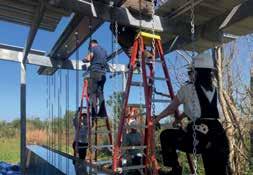
Chapter Four, “A Responsibility to Place,” discusses the importance of designers learning to think on a global scale through better understanding the local complexities of place. The chapter compels educators and the profession alike to consider alternative ways to teach and practice that reflect deeply on the ecology—social and natural—of the place in which they teach and work. And, through that reflection, find respect and even reverence. This is exemplified through the participatory research documented in the book’s many photographs: students walking the beach or hiking coastal prairie trails, witnessing waterfowl and sea life exist side-by-side with the ever-sprawling gated communities that elbow each other out for a glimpse of the ocean, kayaking in bay waters as looming refineries fill the horizon as far as the eye can see. These experiences drive home that they are at ground zero of one of the largest petrochemical manufacturing complexes in the world. These experiences offer pause, allowing students to reflect on how their more-thorough understanding of a place through experience will better shape their work. Taking it all in, the book describes how G cdl students begin to recognize the hard truth that the health of the coast has been sacrificed for the short-term gains that oil, gas, and chemical production deliver, something they may not have given much thought to before. It is a place where they quickly realize that many of the problems we face as a society have no answers when approached with conventional architectural thinking, forcing many of our students to reconsider their fundamental understanding of architecture. These first four chapters contend that getting out of the classroom and into the world challenges the idealized architecture many students may be used to pursuing—at least the way it’s often depicted in design schools as a pleasing, equitable context full of designer buildings where people with “taste” want to live. When face-to-face with the contradictions and vitality that is the coast, students realize they are about as far from the fantasy of heroic architecture as one can get. Yet some find an unexpected energy to it all—a kind of horrific beauty, a Mad Max–meets–Wizard of Oz aesthetic of industrial materials and buildings on stilts
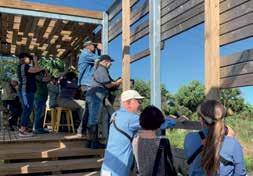
20 Introduction
Bird enthusiasts look out over the wetlands from OBSERVE, the Oppenheimer Bird Observatory on Galveston Island.
© Mary Warwick
Students install a gutter and rain chains over the native plants aquatic garden at SUSTAIN, a new field station for K-8th grade kids at Crenshaw School for Environmental Studies in Port Bolivar, TX. © Coleman Coker
that has a dark attraction, and is evidence of the resilience of the human spirit even in the most extreme contexts. Much like the G cdl stu dio itself, the book highlights these insights by discussing the glaring differences of wealth, class, environmental injustice, and inequity that are out in the open for students to witness. Students see that, just like the health and vitality of the “natural” environment, these human factors hang in the balance between corporate greed and societal need. In this post-industrial, post-nature, post-human culture, the book depicts how the “dirty coast” is a place where students’ untested ideals about design are challenged, where an expanded possibility for architecture’s potential might be realized through a new kind of ecological thinking.
If your heart is not breaking by what is happening to the earth, it is because you don’t yet understand the magnitude of the harm we are doing. Once you become mindful of the impact we’re having, you can either sink into griefstricken hopelessness or you can take that sorrow and turn it into an expression of hope by working to change what’s causing the devastation. No matter how small, committing to help better the world is the most courageous thing you’ll ever do. Courage is necessary for all of us if we are to honestly face this existential threat and admit we are the problem. Courage is essential if we want to step out of our comfort zone and commit to making a better world. It is from this standpoint of knowledgeable activism, that the book’s conclusion, “Ripples of Hope,” reveals its core concept: This book is really about you, the reader. Highlighting the outstanding work of over three-hundred-and-fifty G cdl stu dents, we hope to inspire you, to motivate, and hearten you. If you are not already steadfast and working to make the world just a little bit better for yourself and others, we believe the work of our students will encourage you to do just that, to make a difference, no matter how large or small. Environmental Activism by Design asks you to open yourself to the world and bear witness to the beauty and complexity that is all around. Experience it and embrace it, just like many of our students have, with fresh eyes and an open heart. Whether educator, practitioner, student or someone simply interested in imaginative pragmatism, you will find this world can be an extraordinary place providing everything you desire. It offers drop-toyour-knees beauty that fills our spirits, and it’s telling us now, more than ever, that it needs our love, hope, and respect. Once you find your relationship with it—see, smell, hear, touch, and taste the all-encompassing quality of all that it is—we’re convinced you’ll be encouraged to take a little better care of this earth and all the living souls that depend on it. This is the desire we have for you in writing this book. Know that you can make a difference.
Endnotes
21
1 Joseph Hernandez, (IHNABIT, Summer 2018), Response to GCDL Alumni Questionnaire, 27 September 2021.
Students discuss the potential ecological impacts of their design for DUNE in Port Aransas, TX.
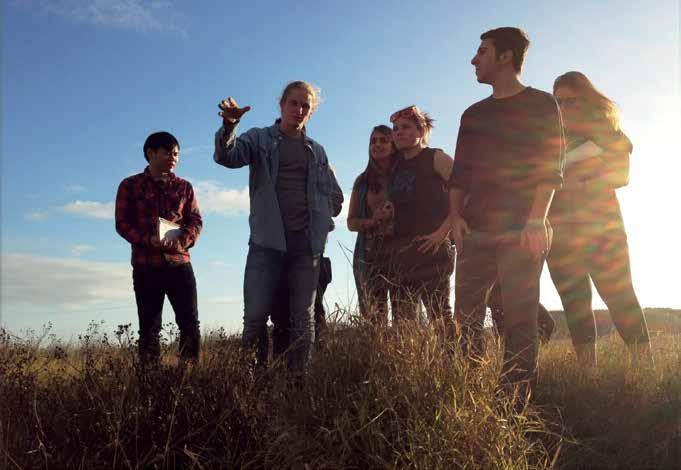
22 Introduction
© Coleman Coker

23
Students relax at GATHER at Goose Island State Park on the Lamar Peninsula. © Coleman Coker

24 Introduction
View looking up through the way-finding tower of FLOAT in Sea Rim State Park’s wetlands preserve near Port Arthur, TX.
© Coleman Coker
Projects Catalogue
The project catalogue highlights each of the twenty-nine projects undertaken by Gulf Coast DesignLab students over the past ten years. Listed in chronological order, each project entry highlights the names of participating students and teaching assistants (when applicable), paired with the client name and project location. Each of the twenty-six Texas projects is physically located on a corresponding project map, which can be found on the inner fold of this book’s back cover.
Each project is given a unique name. These names are collectively determined by the students and the outcome of an exercise given early on in the semester, prior to the start of their design work. While on-site for the first time, the students are asked to find a place to sit quietly and alone for twenty minutes (no earbuds, please) to reflect on what they are sensing. Using all their senses—not just sight—they are asked to make notes of their experiences, and then, to arrive at five action words that capture their reflections. (Occasionally, this assignment will be accompanied by an additional sketch exercise, a mechanism to further concentration on their locale and begin to build a relationship with it.) Toward the end of the studio’s design phase and when they are heavily invested in their project direction, each student is asked to select an action word that describes the chief active characteristic of their design. Once chosen, the students share their words, which are then discussed by the group as a way to find commonality of intent. From these shared words, the students select a name—typically one word but not exclusively—on which they can all agree describes what the project sets out to do. The outcome of this process are names such as culti Vate , moV e , hide , F rame , dem onstrate and su stain, each with the intent of conveying a design idea through the power of words.
25
Fall 2012 | South Texas Botanical Gardens and Nature Center | Corpus Christi, TX
Project Team: Elizabeth deRegt, Laura Edwards, Wilson Hack, Jena Hammond, Jon Handzo, Jaclyn Hensy, Jessica Painter, Molly Purnell, David Schneider, Greg Street, Tristan Walker. © Coleman Coker

Spring 2013 | University of Texas Marine Science Institute | Port Aransas, TX
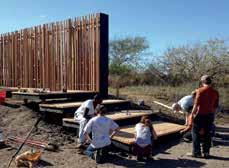
Project Team: Timothy Campbell, Todd Ferry, Garland Fielder, Matt Krolick, Jon Mautz, Lauren Mullane, Annie Palone, Katherine Russett, Jessica Zarowitz. © Coleman Coker


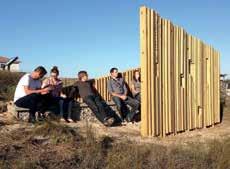
Summer 2013 | City of Austin Parks and Recreation Department | Austin, TX
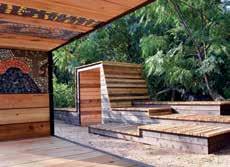


Project Team: Catherine Berry, Ana Calhoun, Brittany Cooper, Alessandra Figueiredo, Nicole Joslin, Cameron Kraus, Tran Hoang Le, Andrea Lewis, Jordan Teitelbaum, Riley Uecker, Carrie Waller | Teaching Assistant: Conner Bryan. © Coleman Coker
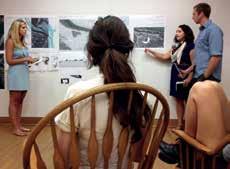
26 Projects Catalogue 01 PARTING WALLS
03 PORTAL
02 BLIND SIDED
Summer 2013 | City of Austin Parks and Recreation Department | Austin, TX



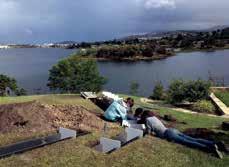
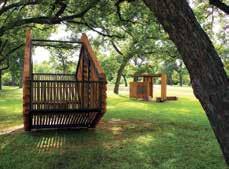
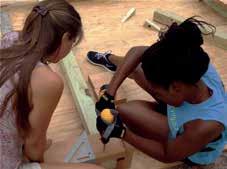
Project Team: Casey-Marie Claude, John Cunningham, Kelly Denker, Brian Gaudio, Anna Katsios, Gordon Lee, Matthew Martinec, Marianne Nepsund, Nathaniel Schneider, Daniel Sebaldt, Allison Stoos | Teaching Assistant: Conner Bryan. © Coleman Coker
Fall 2013 | Museum of Old and New Art (MONA) | Hobart, Tasmania, Australia

Project Team: Shelby Blessing, Danuta Dias, Shelley Evans, Andrew Houston, Lauren Jones, Kye Killian, Alex Krippner, Jorge Martinez Jr, Morgan Parker, Mitch Peterson, David Sharratt, Katie Summers. © Morgan Parker, 1 © Coleman Coker, 2-3
Spring 2014 | The University of Texas Marine Science Institute | Port Aransas, TX

Project Team: Peter Binder, Sara Fallahi, Jorge Faz, Kimberly Harding, Christina Hunter, Yinrui Li (Nicholas), Barron Peper, Ryan Rasmussen, Shelby Sickler. © Coleman Coker
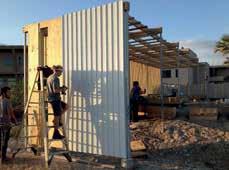
27 04 EXPANDED FIELD 05 HEAVY WATER 06 DUNE
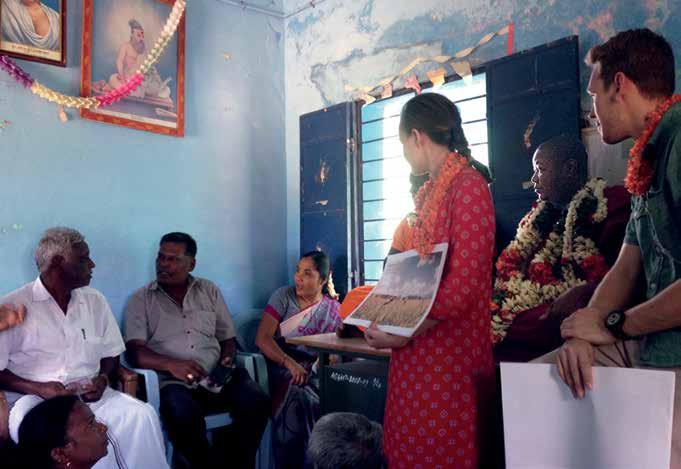
188 Ripples of Hope
Students from the VANAKKAM studio get feedback on their Bodhidharma School design from village elders of Alleyendal in Tamil Nadu, India. © Aimée Toledano
Why Do We Do What We Do?
Katie Swenson
Ithought about this question a lot during a three-week trip to the mass Design Group office in Kigali, Rwanda. Here, we have nearly 70 people working on the design team—architects, landscape architects, engineers, filmmakers, writers, furniture makers, and more. We also started a construction team, called MASS. Build, which has employed more than 2,500 people in the last year. What are the results of the hard work of these talented people? Two new hospitals (one urban, one rural), a new university in Kigali, a center for gorilla research, a new agricultural university, a center for entrepreneurship, and much more. In addition to these tangible, built results, I wonder what this work has meant for the individuals involved? How has the process—as well as the product—influenced the lives of the designers and builders? And how does their motivation to do what they do make a difference in the quality of the work and impact the outcomes?
Soon after graduating with my Master of Architecture in 2000, I joined the Enterprise Rose Fellowship program to work as a designer at a local community development organization in Charlottesville, VA. I was ambitious, but inexperienced. My goal was to integrate best practices in high-quality design and green building into the affordable homes I was charged to design. I turned to both peers and leaders in the field to guide me. One day, I called the office of architect Coleman Coker. I had never met Coleman, but I had admired his work from afar. My impression of his architecture, just from the photos, was that it was grounded in a certain kind of caring. It reflected respect for people, honoring of the natural setting, and elegance of design that wasn’t showy, but deeply appealing. They were places I would want to live and would be proud to design.
Now that I have gotten to know Coleman over the past twenty years, it is not a surprise that he took my cold call. He talked me through a couple of design features I was interested in—the metal roofs, in particular—and followed up
189 AFTERWORD
with some helpful hints. A few years later when I was in Memphis, I stopped by his office to meet him in person. As he came to life with his warm welcome and gentle nature, I understand that his reasons for doing what he does, and the care with which he does it, is manifest in his design.
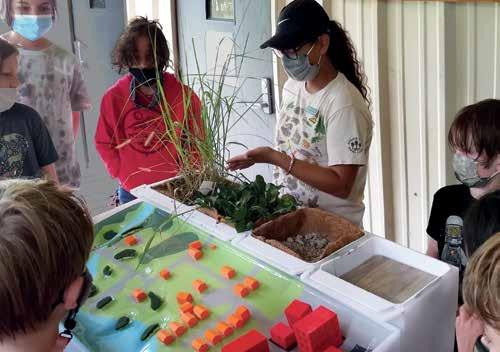
Why do we do what we do? When I try to understand for myself why I care so deeply about high-quality affordable housing, I trace my inspiration to two things. The first is the beautiful, safe, secure home my parents made for me; the second was volunteering at a shelter for homeless women in high school, where I learned about the horrors of homelessness. The disparity between these two realities was sharp, clarifying for me a passion to work to address the lack of affordable homes for everyone, especially women.
Over the course of my career in design, my “why” has evolved, as I have spent more time with people than at the computer, more time on site than in the office. I began to understand that, for me, cultivating the means for others to pursue their passion was an essential way to address larger, systemic problems like these. I became more interested in lifting the talents of others and helping them pursue their mission in design. The profound benefit of this was getting to know people, first all over the US, and now all over the world.
This kind of exposure is key, and it’s certainly the reason why travel is so important in understanding the unique beauty, culture, and challenges of communities around the world. But perhaps equally importantly, it’s the people who we meet along the way: the teachers, the mentors, the people we admire, our friends, strangers who become friends. We also learn through doing—through
190 Why Do We Do What We Do?
Middle school students take part in a water runoff demonstration at the Armand Bayou Nature Center in Houston, TX. Soils containers and enviroscape model were made by students from the SIMULATE studio. © Heather Millar
the teaming, through the designing, through the construction, through the pain points.
And so, I found myself in Rwanda, there to develop strategies to support each member of our team. In architecture, we often talk about the buildings, and this team is creating important ones, but our goal at this moment is to invite people to reflect on their aspirations and how they want to grow in their capabilities, careers, and lives.
Asked to reflect on what motivates them, a few of the mass Design team in the Kigali office said this: I do what I do because….
“I want to be a part of a team that does good in the world.”
“I am for people, and I like to see people grow in all aspects. Better designs improve life and experiences.”
“I have a duty to serve the nation and beyond.”
“I believe in protecting the environment, and using my skills to achieve this gives me purpose.”
“It fulfills me, and through it, I can breathe.”
I believe these kinds of personal commitments make a difference. No matter the scale of a challenge we face, whether the design of a small building or working to curb climate change, we accomplish nothing by ourselves. We are always working in teams or within communities. The quality of our relationships has a
Students from the YUCATAN studio research salt production at Laguna Rosada, Golfo de México, Yucatan, where sea salt has been made since the time of the Mayans. Students designed a project there for visitors wishing to learn more about the history of sea salt production.
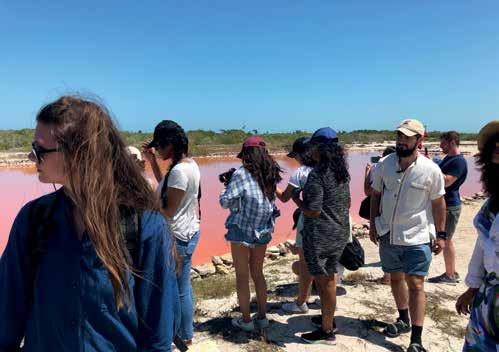 © Coleman Coker
© Coleman Coker
191
direct impact on the quality of the work. When we are aligned with our personal passion and our professional mission, we perform better. We make sure it’s right. We hunt down the thing that’s bothering us, we correct it. But this kind of commitment, I believe, can only be fueled from the inside. Outside forces can affect minor change, but anything worthwhile starts from within. And, when we elevate the individual missions of the people with whom we are working, we do better together. But that also demands courage.
School is one of the places where we expect this kind of personal exposure, development, and transformation. As students head out into the world, the problems they face seem insurmountable. Every person I have met in the field of architecture has a fundamental desire to improve the world through design. But where to begin? How does one turn that lofty idealism into action, into work?
Coleman, Sarah, and the Gulf Coast DesignLab are giving the clues, demonstrating that the classroom can provide the platform for learning, but that nature—the real world, real people, real threats—is the kind of environment where young people can start to challenge themselves to develop their personal commitments. They can get into the messy complexity of life, learn on the job, and not be scared to try. The passion and care of teachers, mentors, community members, peers working in teams—these are the people who help guide us, pick up the phone, welcome us into their lives.
Reflecting on your “why,” even as it changes, is a critical tool in bravely taking action. Doing the work of cultural change takes courage. Doing environmental work takes courage. Developing that courage is the learning, it is the lesson. Thank you to Coleman, Sarah, and the students of the Gulf Coast DesignLab for reminding us.
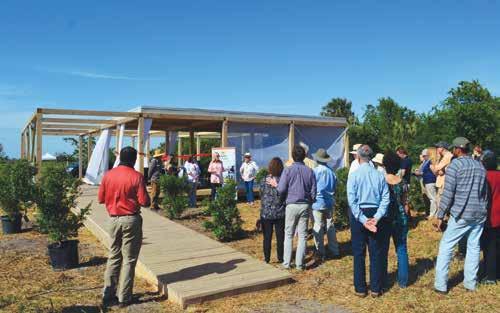
192 Why Do We Do What We Do?
Supporters gather at Artist Boat’s Coastal Heritage Preserve to celebrate their new outdoor classroom, FRAME © Coleman Coker

193
Young visitors in East Austin’s Boggy Creek Park are drawn to the cast-in-concrete relief map showing the surrounding neighborhood in threedimensional form.
© Coleman Coker
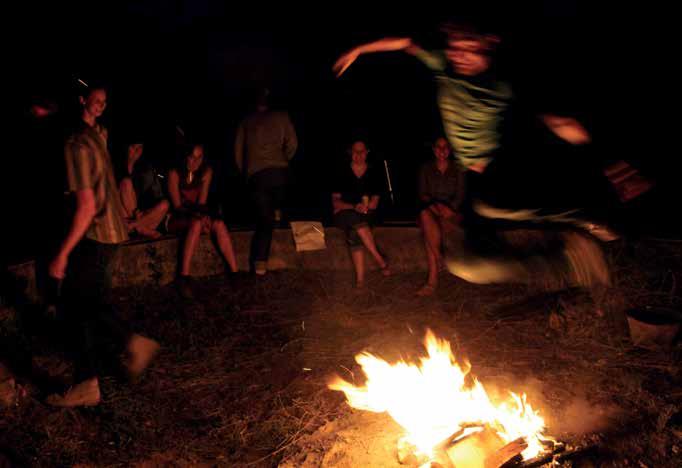
194 Why Do We Do What We Do?
Students celebrate the completion of PARTING WALLS, located in the native plants area of Corpus Christi Botanical Gardens.
© Wilson Hank
Acknowledgments
Many thanks to Coleman Coker for his generosity and patience throughout the making of this book. Through our collaboration, I learned so much about teaching and practice, emerging as a more thoughtful architect and grateful for his influence. Thank you to Texas Architect magazine and former editor Aaron Seward for inviting me to write about Gcdl’s Float in 2017, which jumpstarted this collaboration with Coleman. Thank you to the Gulf Coast DesignLab alumni and clients who shared their thoughts and personal experiences with me through one-on-one interviews and responses to the alumni questionnaire: Natalie Avellar, Nai’lah Bell, Sara Bensalem, Kate Bomar, Victoria Carter, Jacob Castine, Peiwei Chang, Connie Chang, Wellington Chew, Arlene Ellwood, Justin Fluery, Andy Garden, Susie Gibson, Evan Gruelich, Jaclyn Hensy, Joseph Hernandez, Tj Hinojosa, Hannah Ivanci, Christie Johnson, Thomas Johnston, Alex Kelley, Karla Klay, Laura Marley Lancaster, Joshua Leger, Max Mahaffey, Omar McClung, Aaron McMurry, Whitney Peper, Draven Pointer, David Schneider, Andrew Stone, Iuliia Tambovtseva, Nieve Tierney, Claire Townley, Tristan Walker, Charlie Weber, Fiona Wong, and the several contributors who preferred to remain anonymous.
Thank you to the University of Florida College of Design, Construction, and Planning Dean Chimay Anumba and Associate Dean for Research and Strategic Initiatives Margaret Portillo for their support, including subvention funds and financial support for graduate student research. Thank you to my current and former faculty colleagues at the u F and ut Austin architecture schools for their support and encouragement, with special appreciation to u F director (and former directors) David Rifkind, Frank Bosworth, and Jason Alread; u F faculty Martin Gundersen, Nina Hofer, Donna Cohen, and Jeff Carney; and u t Austin faculty Nichole Wiedemann and Judith Birdsong. Thank you to u F graduate
195
Sarah Gamble and Coleman Coker
research assistant Carly Walker for her dedication and attention to detail in processing through the countless interviews, questionnaire responses, and other research that fed into this publication. Thank you to editor Heather Corcoran for her insightful feedback and guidance. Thank you to my parents, Chip and Gail; my husband, Jason; and my son, Wyatt, for their continued patience, enthusiasm, and support.
Sarah Gamble
Many thanks to Sarah Gamble for her enthusiasm, energy, reliability, and grant-writing skills that helped make this book possible. In addition to her research and writing, her tireless work of gathering alumni and client quotes about their experiences in the G cdl is greatly appreciated, as is her affinity for deadlines and schedules, which kept me on track. I want to thank my many talented colleagues at the University of Texas at Austin School of Architecture for their ongoing advice and encouragement and former dean Fritz Steiner, who generously offered his much-needed support when the program began. Thank you to the Ruth Carter Stevenson Chair in the Art of Architecture for its years of financial support as the program began. Thank you to Dean Michelle Addington, who generously made her Houston Foundation gift available for much of the book’s production, as well as the utsoa’s Advisory Council member Tammy Chambless for her generous financial gift that helped fund graduate research assistants’ work on the book. I want to recognize the many other donors, volunteers, and in-kind providers who have helped make the students’ work possible. Thank you to Professor Kevin Alter, who first invited me to the School of Architecture and has offered his continual support and friendship over these eleven years since. I’d like to also acknowledge Professor Michael Benedikt for his always-reliable advice and support on the book and for his years of encouragement, guidance, and friendship.
Many thanks to Tom Fisher and Katie Swenson, not only for their contributing essays but for their long-standing insistence that our profession be more ethical and loving. I need to thank the many stakeholders and clients we have worked with over the years. It goes without saying that without them, the DesignLab would have only been an idea that never came to fruition. I also want to acknowledge Leora Visotzky for her under-the-radar support over the years as well as her keen editorial eye. And to Sarah Wu for her never-ending optimism and the many unsung contributions she has made to our School. Also, Charlie Weber for his initial research and graphic advice, to Victoria Carter for her steady graphic hand, Evan Greulich, Max Mahaffey, Kaethe Selkirk, Noah Winkler, Thomas Johnston, April Ng, Whitney Peper, David Schneider and Josh Leger for their assistance and creativeness, as well as the many talented research assistants who helped keep the program running smoothly. Most of all, I want to thank the over three
196 Acknowledgments
hundred and fifty students who have participated in more than twenty-five Gulf Coast DesignLab projects. While I am listed in the University catalogue as their professor, they will never know what extraordinary teachers they have been for me, giving their time, talent—even sweat and blisters—and willingness to go far beyond what is typically expected in any design studio. Their unswerving perseverance has earned my deepest respect and changed my life’s direction. I need to acknowledge the intense beauty and complexity that is the Gulf Coast, a living affirmation that the world is astonishing beyond description and worth our every effort to let it thrive. Without it, the DesignLab would not exist. And to Jay, who always encouraged me to return to others some of what life provided; she lives in my heart.
Coleman Coker
197
Author Bios
Coleman Coker
Coleman Coker, ra , is the Professor of Practice at the University of Texas at Austin School of Architecture and director of the Gulf Coast DesignLab there. He is a Loeb Fellow in Advanced Environmental Studies at Harvard University Graduate School of Design and a Rome Prize recipient from the American Academy in Rome. Coker has practiced architecture for over thirty-five years. He founded buildingstudio in 1999 after a thirteen-year partnership with Samuel Mockbee as Mockbee/Coker Architects.
Thomas Fisher
Thomas Fisher is a Professor in the School of Architecture, Director of the Minnesota Design Center, and former Dean of the College of Design at the University of Minnesota. The former Editorial Director of Progressive Architecture magazine, he has written or edited 11 books, 70 book chapters or introductions, and over 450 articles in professional journals and major publications. He recently completed a book on the post-pandemic world for Routledge, which will be published in 2022.
Sarah Gamble
Sarah Gamble is an Assistant Professor at the University of Florida School of Architecture, following teaching at the University of Texas at Austin from 2011 to 2018. Gamble’s academic research focuses on context and how the design process is catalyzed by the surrounding environment and designers’ understanding of it. Gamble previously served as Architect of the Texas Historical Commission’s Main Street Program, Principal at GO collaborative, and Architect at the Austin Community Design and Development Center.
Katie Swenson
Katie Swenson is a Senior Principal of mass Design Group, an international non-profit architecture firm whose mission is to research, build, and advocate for architecture that promotes justice and human dignity. Katie received the 2022 aia Award for Public Architecture and is the co-author of Growing Urban Habitats: Seeking a Housing Development Model and author of Design with Love: At Home in America, and In Bohemia: A Memoir of Love, Loss and Kindness.
198 Author Bios








 © Coleman Coker
© Coleman Coker



 ©
©

























 © Coleman Coker
© Coleman Coker



